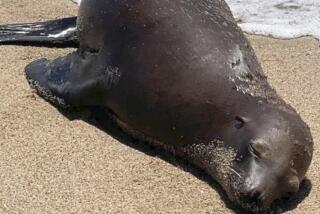Storms Leave Sea Lions Stranded
The cheering began as one of the biggest sets of the day rolled in.
A lone surfer was in the lineup, but nobody cared about him. He got caught inside and, trying to paddle over an 8-footer, was sucked over the falls. His board broke in two, he surfaced and rode the whitewater in on a three-foot chunk of fiberglass and foam, humbled but relieved to be back on land.
The cheering was for a California sea lion that had also come ashore on one of the wildest of many wild days on the waterfront this month.
The waves were so big, they were scraping the bottom of the Manhattan Beach pier. Curious onlookers watched in awe as set after set of thunderous breakers pounded beneath their feet.
As the surfer washed in through a sea of foam, the sea lion was already on the beach, moving its head back and forth, gazing nervously back at the turbulent ocean. A crowd soon gathered around the wayward pinniped. Those on the pier had a bird’s-eye view.
They offered encouragement when the young and slender sea lion, after a brief rest, charged back into the water, only to be forced back by waves of the same set that had pummeled the surfer.
Propped on the wet sand by its flippers, the sea lion mounted another attempt at reaching the open ocean, but was forced back again.
Finally, after catching its breath again, during a lull in the surf, it waddled in at full speed and disappeared for several seconds before surfacing first in the impact zone and then beyond the breakers.
The crowd expressed its relief with claps and smiles. The sea lion had made it to safety. Or so it seemed.
Meanwhile, a couple of miles south at the base of the Hermosa Beach pier, a younger, smaller and weaker sea lion had only a small cheering section, which, in truth, had little to cheer about.
This poor animal obviously was in over its head in such strong surf. It sat there, high and dry on a sand berm, its ribs showing through its baggy skin, its large black eyes staring out at its topsy-turvy world, possibly searching for its mother.
On the pier, one of a small group of women made a suggestion.
“Somebody really should throw some water on that poor animal,” she said. “He’s all dry. Shouldn’t he be wet?”
And so it has gone this crazy winter . . .
Mighty El Nino, which had already dealt seal and sea lion populations a severe blow by driving much of their prey from Southland waters, has been delivering a knockout punch of sorts in recent weeks with heavy surf.
Sea lions in particular, most pups and many weak and malnourished, have been showing up on Southland beaches in unusually high numbers. And a well-meaning but largely misinformed public has no clue what to do when face-to-whiskered-face with one of them.
“Throwing water on that sea lion would have been the worst thing to do,” said Jackie Ott, operations manager at the nonprofit Marine Mammal Care Center at Fort MacArthur on the Palos Verdes Peninsula. “That animal was on the beach because it needed to rest and get warm. You’d be tired too if you were out in the ocean during all that.”
At the care center, “We’re treating El Nino as a war, taking only the debilitated animals first,” Ott said.
The war is not going well.
The most animals the facility had had at any time was 47, and there are now more than 70. Ott and the center’s only other full-time employee are working 80-hour weeks. The hours are piling up for volunteers as well.
“My wife gets up at 3 every morning to go there and get all the fish prepared, skinning them for the blender and making fish milkshakes for the sea lions,” said Hugh Ryono, a spokesman for the center. “You know what time I get to see her again? About 8 or 9 at night.”
It’s the same story at the few other care centers from Santa Barbara to San Diego.
The unusually warm water generated by El Nino is responsible for displacing the sea lions’ food supply--largely squid, anchovies, mackerel and herring--around the major rookeries of the Channel Islands.
This phenomenon led to a major die-off a few months ago of fur seals and sea lions in the northern Channel Islands, particularly at San Miguel Island, where there is a sizable colony of seals and an enormous colony of sea lions.
If there is a silver lining to this, many of the sea lion pups that were expected to die survived.
“And many of these are coming to the mainland,” said Joe Cordaro, a Long Beach-based biologist with the National Marine Fisheries Service. “In most cases these are not abandoned pups, but animals that have already weaned and are looking for fish on their own.”
Cordaro said it is not normal for sea lions to venture so far from the islands at such a young age--most of those showing along the coast were born in June--but the lack of food has given them no choice.
Their mothers have been forced to travel farther, and with them gone for increasingly long periods, impatient and hungry pups set out on their own.
So many have come ashore in recent weeks that the fisheries service has instituted a 48-hour wait-and-watch policy for all stranded pinnipeds on Southland beaches. If an animal remains ashore after 48 hours, its case is reevaluated. Whether it is placed in a care facility depends on the animal’s condition and available space.
The sea lion pup beneath the Hermosa Beach pier was ogled over by passersby and pier strollers for two days--looking much healthier and very much the ham on the second day--before it disappeared, presumably back into an ocean that had calmed considerably.
The next series of major storms, and the large swells that accompany such storms, undoubtedly will lead to more young sea lions coming ashore for a breather.
Cordaro, who said there have been several reports of people feeding the mammals and at least one incident involving a person who was bitten, asks that people leave them alone and reminds them that approaching or harassing them is in violation of the Marine Mammal Protection Act.
Ott, who operates the only care center in the Los Angeles area (there is also the Friends of the Sea Lion in Laguna Beach and Sea World in San Diego), said if a seal or sea lion appears alert it should be left alone because it is probably only resting or trying to get warm.
But if it appears wounded or is being bothered by the presence of humans, the care centers or fisheries service should be made aware of the situation so the sea lion can be monitored by those authorized and trained to do so.
What people can do if they really want to help, she stressed, is make a financial donation to the center, which is especially strapped with all the incoming mammals.
“It’s imperative this year to get funds,” she said. “Last year we treated 158 animals. This year we’re up to 101 already since Jan. 1 and we’re not even into the normal busy period yet.”
The Marine Mammal Care Center is located at 3601 South Gaffey St., San Pedro, 90731.
WHERE THEY’RE BITING
Two weeks of rain and a heavy surf seems to have driven thousands of yellowtail from the Santa Monica Bay. If you’re looking for action on the exotics, look south. The striped marlin bite before the full moon was incredible off Cabo San Lucas, and as the full moon wanes, the bite is rebounding nicely.
However, one of the best striper bites is in the East Cape region, where it is possible to catch three or four on a good day. Trouble is, northerly winds have been raging over the region. Of note: Bobby Van Wormer, fishing director at hotels Punta Colorada, Playa del Sol and Palmas de Cortez, announced the purchase of a new fleet of cruisers for $700,000. The combined fleet now totals 70 vessels, giving the Van Wormers the largest fleet in Baja and possibly in all of Mexico.
In Mazatlan, swordfish are beginning to show in large numbers, but they aren’t biting. Anglers are concentrating on large tuna, with fish coming in at up to 137 pounds, the Aires Fleet reports. Farther south at Zihuatanejo, they’re raising plenty of sailfish, but the bite is anything but wide open.
ROCKY RECEPTION
Karen Thorndike, the Seattle sailor trying to become the first American woman to circumnavigate the world solo, made landfall late last week at Hobart, Australia, whereupon she was greeted by an escort of tall ships and Tuny Rundel, premier of Tasmania.
“Unfortunately, I cast my dock line up, hitting him square in the face,” Thorndike said. “So he is now the Honorable Tony Rundel with a welt across his face.”
Thorndike, having spent three months covering 10,200 nautical miles on the sixth and longest leg of her journey from Mar del Plata, Argentina, hopes to conclude her voyage this summer.
SHOW-BOATING
The Southern California Boat Show at the Los Angeles Convention Center enters its final weekend, and if it’s anything like opening weekend, boat-makers and show organizers will be ecstatic. Attendance is up 15% over last year and sales are skyrocketing. Sea Ray alone reported sales in excess of
$3 million last weekend alone. Seminar subjects today through closing day Sunday include catching freshwater and saltwater game fish, trailerable boat repair, the use of global positioning satellites and wakeboarding.
THE CHUM LINE . . .
What better way to kick off Valentine’s Day? The staff at Silverwood Lake State Recreation Area is requesting the help of volunteers to count bald eagles beginning at 8 a.m. Saturday. Bring binoculars and dress warmly. Details: (760) 389-2303.
The Department of Fish and Game’s popular Becoming An Outdoors Woman workshop will be held March 27-29 at rustic Camp Rancho Alegre in Santa Barbara County. Courses--there are 29--include fishing, cooking, map and compass reading, bow hunting, camping, hiking and firearm safety. Cost is $175. The workshop fills up fast and those interested should call (916) 657-4333 for registration packets. You can find them on the Internet at www.dfg.ca.gov/owoman.html.
Montana guide and fly-tier Bob Krumm will give a presentation at Thursday’s meeting of the Sierra Pacific Flyfishers. The program, at the Encino Glen restaurant, begins at 6:30 p.m. Cost is $22. Reservations: (818) 789-1919.
Novice sportsmen can obtain their huntersafety certificate by taking a 10-hour course Feb. 21 or March 21 at Mike Raahauge Shooting Enterprise in Corona. Cost is $35. Details: (800) 773-4868.
More to Read
Sign up for Essential California
The most important California stories and recommendations in your inbox every morning.
You may occasionally receive promotional content from the Los Angeles Times.










